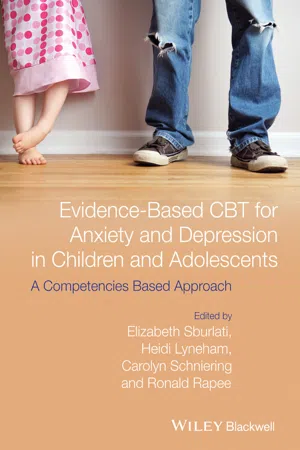
Evidence-Based CBT for Anxiety and Depression in Children and Adolescents
A Competencies Based Approach
- English
- ePUB (mobile friendly)
- Available on iOS & Android
Evidence-Based CBT for Anxiety and Depression in Children and Adolescents
A Competencies Based Approach
About this book
"This should be on the bookshelf of everyone treating anxious and depressed children and adolescents. A cornucopia of theory and clinical good sense alike. I will be making sure that my trainees read it cover to cover."
Dr Samantha Cartwright-Hatton, Senior Clinical Research Fellow in Psychology, University of Sussex
This is the first book to offer an explicitly competencies-based approach to the cognitive behavioral treatment of anxiety and depression in children and adolescents. Within it, an outstanding and influential set of experts in the field describe a comprehensive model of therapist competencies required for empirically supported cognitive behavioral treatment. They explore each of these competencies in great detail, and highlight effective ways of training them. As a result, the book not only supports the training, development, and assessment of competent clinicians who are implementing CBT, it is also invaluable for clinicians who wish to gain an understanding of the competencies they need to acquire or improve, and offers guidelines for how to achieve these, providing a benchmark against which they can assess themselves. Evidence-Based CBT for Anxiety and Depression in Children and Adolescents works to improve the quality of therapists working in this area, and, as a result, the quality of treatment that many young people receive.
Frequently asked questions
- Essential is ideal for learners and professionals who enjoy exploring a wide range of subjects. Access the Essential Library with 800,000+ trusted titles and best-sellers across business, personal growth, and the humanities. Includes unlimited reading time and Standard Read Aloud voice.
- Complete: Perfect for advanced learners and researchers needing full, unrestricted access. Unlock 1.4M+ books across hundreds of subjects, including academic and specialized titles. The Complete Plan also includes advanced features like Premium Read Aloud and Research Assistant.
Please note we cannot support devices running on iOS 13 and Android 7 or earlier. Learn more about using the app.
Information
1
An Introduction to the Competencies-Based Approach
The Genesis of This Book
Empirically supported treatment, evidence-based practice, and the real world
The competencies-based approach
A model of therapist competencies for the evidence-based treatment of child and adolescent anxiety and depressive disorders
Sburlati et al. (2011) domains of competence
Generic therapeutic competencies
| Category | Individual competencies |
|
|
Table of contents
- Cover
- Title page
- Copyright page
- Dedication
- Notes on Editors
- Notes on Contributors
- 1 An Introduction to the Competencies-Based Approach
- 2 Effective Training Methods
- Part I: Generic Therapeutic Competencies
- Part II: CBT Competencies
- Part III: Specific CBT Techniques
- Index
- End User License Agreement